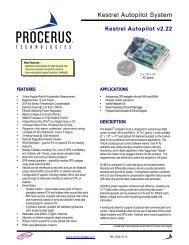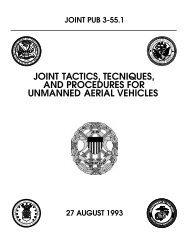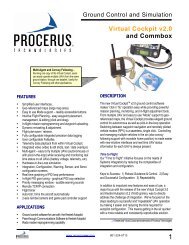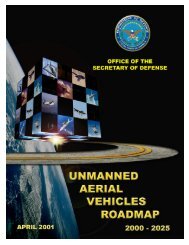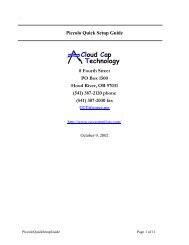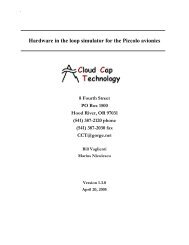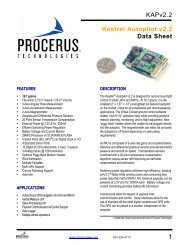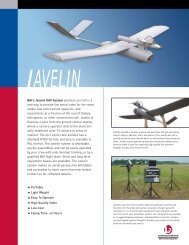- Page 5 and 6: UAV Roadmap 2002Executive SummaryTh
- Page 7: UAV Roadmap 20022. Develop and demo
- Page 10 and 11: UAV Roadmap 20024.2 PAYLOADS ......
- Page 12 and 13: UAV Roadmap 2002FIGURE D-8: PAYLOAD
- Page 14 and 15: xiiUAV Roadmap 2002
- Page 16 and 17: UAV Roadmap 2002 - Section 1Introdu
- Page 19 and 20: 2.0 Current UAV ProgramsUAV Roadmap
- Page 21 and 22: UAV Roadmap 2002 - Section 2Current
- Page 23 and 24: UAV Roadmap 2002 - Section 2Current
- Page 25 and 26: UAV Roadmap 2002 - Section 2Current
- Page 27 and 28: UAV Roadmap 2002 - Section 2Current
- Page 29 and 30: UAV Roadmap 2002 - Section 2Current
- Page 31 and 32: UAV Roadmap 2002 - Section 2Current
- Page 33 and 34: UAV Roadmap 2002 - Section 2Current
- Page 35 and 36: UAV Roadmap 2002 - Section 2Current
- Page 37: TABLE 2.5-2: MTCR MEMBER INTEREST I
- Page 42 and 43: UAV Roadmap 2002 - Section 3Require
- Page 44 and 45: UAV Roadmap 2002 - Section 4Technol
- Page 46 and 47: 4.1.3 Cost ControlUAV Roadmap 2002
- Page 48 and 49: 4.2 PayloadsUAV Roadmap 2002 - Sect
- Page 50 and 51: Calendar YearsUAV Roadmap 2002 - Se
- Page 52 and 53: 4.2.2 Communication RelayUAV Roadma
- Page 54 and 55: UAV Roadmap 2002 - Section 4Technol
- Page 56 and 57: Processor SpeedUAV Roadmap 2002 - S
- Page 59 and 60: 5.0 OperationsUAV Roadmap 2002 - Se
- Page 61 and 62: 5.1.3 Air ForceUAV Roadmap 2002 - S
- Page 63 and 64: UAV Roadmap 2002 - Section 5Operati
- Page 65 and 66: TABLE 5.2-1: RELIABILITY METRICS FO
- Page 67 and 68: UAV Roadmap 2002 - Section 5Operati
- Page 69 and 70: 6.0 RoadmapUAV Roadmap 2002 - Secti
- Page 71 and 72: UAV Roadmap 2002 - Section 6Roadmap
- Page 73 and 74: UAV Roadmap 2002 - Section 6Roadmap
- Page 75 and 76: UAV Roadmap 2002 - Section 6Roadmap
- Page 77 and 78: 6.4.7 Airspace GoalsUAV Roadmap 200
- Page 79: UAV Roadmap 2002 - Section 6Roadmap
- Page 82 and 83: UAV Roadmap 2002 - Appendix APlatfo
- Page 84 and 85: UAV Roadmap 2002 - Appendix APlatfo
- Page 86 and 87: UAV Roadmap 2002 - Appendix APlatfo
- Page 88 and 89: UAV Roadmap 2002 - Appendix APlatfo
- Page 90 and 91:
UAV Roadmap 2002 - Appendix APlatfo
- Page 92 and 93:
UAV Roadmap 2002 - Appendix APlatfo
- Page 94 and 95:
UAV Roadmap 2002 - Appendix APlatfo
- Page 96 and 97:
UAV Roadmap 2002 - Appendix APlatfo
- Page 98 and 99:
UAV Roadmap 2002 - Appendix APlatfo
- Page 101 and 102:
Appendix B: SensorsUAV Roadmap 2002
- Page 103 and 104:
UAV Roadmap 2002 - Appendix BSensor
- Page 105 and 106:
UAV Roadmap 2002 - Appendix BSensor
- Page 107 and 108:
UAV Roadmap 2002 - Appendix BSensor
- Page 109 and 110:
UAV Roadmap 2002 - Appendix BSensor
- Page 111:
UAV Roadmap 2002 - Appendix BSensor
- Page 114 and 115:
Future DirectionUAV Roadmap 2002 -
- Page 116 and 117:
High Altitude ISR UAVs.UAV Roadmap
- Page 118 and 119:
UAV Roadmap 2002 - Appendix CCommun
- Page 120 and 121:
UAV Roadmap 2002 - Appendix CCommun
- Page 122 and 123:
• Expanded terrestrial communicat
- Page 125 and 126:
Appendix D: Technology MigrationOve
- Page 127 and 128:
UAV Roadmap 2002 - Appendix DTechno
- Page 129 and 130:
• Platform Related: Propulsion &
- Page 131 and 132:
UAV Roadmap 2002 - Appendix DTechno
- Page 133 and 134:
UAV Roadmap 2002 - Appendix DTechno
- Page 135 and 136:
• Payloads & Sensors: IMINT$40.2
- Page 137 and 138:
• Payloads & Sensors: Communicati
- Page 139 and 140:
UAV Roadmap 2002 - Appendix DTechno
- Page 141 and 142:
Appendix E: Small UAVsUAV Roadmap 2
- Page 143 and 144:
UAV Roadmap 2002 - Appendix ESmall
- Page 145 and 146:
UAV Roadmap 2002 - Appendix ESmall
- Page 147:
UAV Roadmap 2002 - Appendix ESmall
- Page 150 and 151:
UAV Roadmap 2002 - Appendix FStanda
- Page 152 and 153:
UAV Roadmap 2002 - Appendix FStanda
- Page 154 and 155:
UAV Roadmap 2002 - Appendix FStanda
- Page 156 and 157:
UAV Roadmap 2002 - Appendix FStanda
- Page 158 and 159:
UAV Roadmap 2002 - Appendix FStanda
- Page 160 and 161:
UAV Roadmap 2002 - Appendix FStanda
- Page 162 and 163:
UAV Roadmap 2002 - Appendix FStanda
- Page 164 and 165:
UAV Roadmap 2002 - Appendix FStanda
- Page 167 and 168:
Appendix G: AirspaceUAV Roadmap 200
- Page 169 and 170:
UAV Roadmap 2002 - Appendix GAirspa
- Page 171 and 172:
UAV Roadmap 2002 - Appendix GAirspa
- Page 173 and 174:
UAV Roadmap 2002 - Appendix GAirspa
- Page 175 and 176:
UAV Roadmap 2002 - Appendix GAirspa
- Page 177 and 178:
UAV Roadmap 2002 - Appendix GAirspa
- Page 179 and 180:
UAV Roadmap 2002 - Appendix HTask/P
- Page 181 and 182:
U. S. AI R FO RC EUAV Roadmap 2002
- Page 183 and 184:
UAV Roadmap 2002 - Appendix HTask/P
- Page 185 and 186:
UAV Roadmap 2002 - Appendix HTask/P
- Page 187 and 188:
TPPU TechnologiesUAV Roadmap 2002 -
- Page 189 and 190:
Appendix I: WeaponsUAV Roadmap 2002
- Page 191 and 192:
UAV Roadmap 2002 - Appendix IWeapon
- Page 193 and 194:
UAV Roadmap 2002 - Appendix IWeapon
- Page 195 and 196:
UAV Roadmap 2002 - Appendix IWeapon
- Page 197 and 198:
UAV Roadmap 2002 - Appendix IWeapon
- Page 199 and 200:
Appendix J: ReliabilityUAV Roadmap
- Page 201 and 202:
UAV Roadmap 2002 - Appendix JReliab
- Page 203 and 204:
UAV Roadmap 2002 - Appendix JReliab
- Page 205 and 206:
UAV Roadmap 2002 - Appendix JReliab
- Page 207 and 208:
UAV Roadmap 2002 - Appendix JReliab
- Page 209:
UAV Roadmap 2002 - Appendix JReliab



